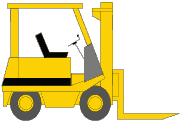|
- 1. When preforming any tests or repairs on a SCR or MOSFET system, always discharge the
capacitors using a resistor or a VOM set to a high voltage scale. A 220 ohm resistor will work well if placed across
the capacitor leads; hold it for a couple of seconds to insure it is fully discharged. To make sure the capacitor
is discharged, measure the voltage with your VOM. Be sure to keep your fingers off the resistor leads themselves
by holding the body of the resistor or insulating the resistor leads. Using a VOM will discharge the capacitors
very slowly due to the high internal resistance, but at least you will be sure the capacitor is fully discharged
when the meter reads zero volts. Don't forget to disconnect
the battery first!!
- 2. An additional test to make on any power SCR is to measure the GATE to CATHODE resistance.
A typical measurement should be between 20 and 50 ohms. If a measurement of less than 10 ohms exists, the SCR is
concidered insensitive and will require a stronger pulse to gate on. If the measurement is more than 125 ohms,
then the SCR is concidered too sensitive and may fire erratically on noise pulses. In either case, I would recommend
replacing the SCR.
- 3. When working with circuit boards that have flat contacts, never use a wire brush to
clean the contacts. The best way is to use a pencil eraser; I generally carry a full size artist or drafting eraser.
A standard pencil eraser will work but will not last very long. For best results clean the contacts of oil or grease
with plain alcohol then use your eraser to put a final shine on the contacts. Abrasives will only damage the surface.
- 4. Most panel assemblies have large power components mounted on heat sinks for proper
heat dissipation. Between the heat sink and panel baseplate you will find an insulator to electrically isolate
the two. By using an ohmeter, check to make sure that the insulator has not broken down. Use the highest resistance
scale and measure between heatsink and baseplate; you should show infinite resistance (a total open conection).
- 5. Keep in mind that when you're working with the main control cards that there may be
terminal strips attached to the card that are not part of the card . As an example, a General Electric EV-1 control
card has left and right terminal strips that connect to the control card itself. If you are taking measurements
to the terminal strips, remember that there is also a connection from the terminal strip to the control card which
may be defective. The EV-1 terminal strip has two small finger connections that connect to the control card. It
is always a good idea to remove these strips, and using a small pair of needle nose pliers, pinch these fingers
together to make sure your connections are secure.
- 6. Never replace fuses with other than the proper value fuse. If a fuse continues to blow
that means there is a short or partially shorted circuit in the system. Even though a #8 screw will fit most fuse
holders, I don't recommend using them to replace fuses.
- 7. Never disable the 1A or Bypass circuit to reduce the overall speed of the vehicle.
This will only lead to overheating of the panel and cause thermal problems and premature SCR failures. Typically
the bypass is used not only to increase speed but also to give the SCRs a chance to rest and cool-off.
- 8. When taking voltage measurements in any electronic system, it is very important to
understand where to reference your meter. When taking voltage measurements, 99.9% of the time you should reference
your meter to battery negative. That means connect your battery negative lead, or black lead to vehicle battery
negative. This way you will always read a positive voltage and you will also be reading voltages like every other
electronics technician.
|


